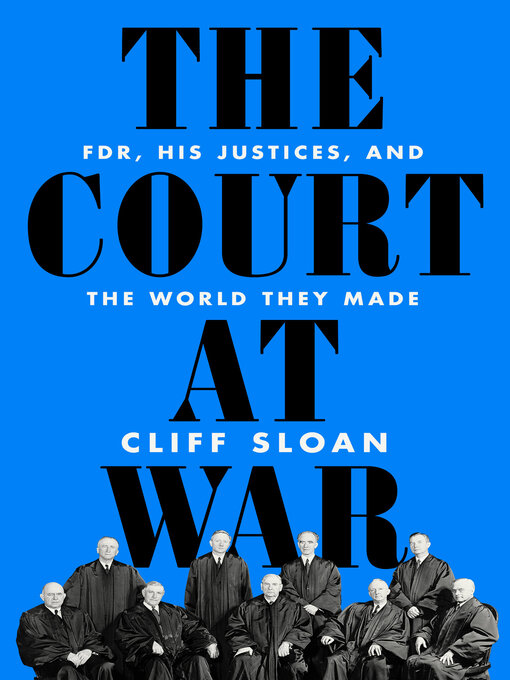- All Fiction
- Military Fiction
- Historical Fiction
- Mystery & Thriller
- Romance
- See all fiction collections
By the summer of 1941, in the ninth year of his presidency, Franklin Roosevelt had molded his Court. He had appointed seven of the nine justices—the most by any president except George Washington—and handpicked the chief justice.
But the wartime Roosevelt Court had two faces. One was bold and progressive, the other supine and abject, cowed by the charisma of the revered president.
The Court at War explores this pivotal period. It provides a cast of unforgettable characters in the justices—from the mercurial, Vienna-born intellectual Felix Frankfurter to the Alabama populist Hugo Black; from the western prodigy William O. Douglas, FDR’s initial pick to be his running mate in 1944, to Roosevelt’s former attorney general and Nuremberg prosecutor Robert Jackson.
The justices’ shameless capitulation and unwillingness to cross their beloved president highlight the dangers of an unseemly closeness between Supreme Court justices and their political patrons. But the FDR Court’s finest moments also provided a robust defense of individual rights, rights the current Court has put in jeopardy. Sloan’s intimate portrait is a vivid, instructive tale for modern times.
-
Creators
-
Publisher
-
Release date
September 19, 2023 -
Formats
-
Kindle Book
-
OverDrive Read
- ISBN: 9781541736450
-
EPUB ebook
- ISBN: 9781541736450
- File size: 23886 KB
-
-
Languages
- English
-
Reviews
-
Publisher's Weekly
July 31, 2023
Sloan (The Great Decision), a professor of constitutional law at Georgetown University, offers an astute look at the Supreme Court during WWII, an era that tested the Court’s ability to balance the Constitution’s protections of individual rights against the extraordinary measures the government thought necessary to win the war. Sloan views the Court’s protection of individual rights in a positive light, pointing to the 1942 opinion in Skinner v. Oklahoma denying a state’s ability to forcibly sterilize a criminal defendant, a decision that has become a precedent underlying the right to same-sex marriage; and West Virginia Board of Education v. Barnette, a 1943 decision that protected the rights of Jehovah’s Witnesses to refuse to salute the U.S. flag on religious grounds. On the other hand, Sloan argues the 1944 opinion in United States v. Korematsu that found government had authority to move hundreds of thousands of Japanese Americans into concentration camps in the name of national security stands as one of the worst opinions in the Court’s history. Alongside astute case analyses, Sloan vividly explores the fractious relationships between justices whose judicial philosophies, personalities, and backgrounds radically differed. The result is an accessible narrative that highlights how the forces of history, politics, and personality influenced one of America’s most important institutions at a critical time in history. It’s an entertaining and worthwhile account. (Sept.)Correction: An earlier version of this review misidentified the Supreme Court decision the protected the right to refuse to salute the flag on religious grounds. -
Kirkus
August 1, 2023
The achievements, positive and negative, of the Supreme Court in Franklin Roosevelt's later presidency. When World War II broke out, writes Georgetown law professor Sloan, Roosevelt had appointed seven of the nine men serving on the Supreme Court, "the most Justices appointed by a president since George Washington." The court was inclined to loyalty toward the president, but they were not above the ordinary frictions and squabbles among themselves. Hugo Black, for instance, had once been a member of the KKK. Even though he had become a convert to progressivism, he had little liking for Felix Frankfurter, who gave off an air of professorial arrogance, and their relationship would, "over time, become increasingly intense and toxic." The court tended to divide over some issues but not others. It came together in what has since been much-studied, much-contested back-channel lobbying on the part of the White House to try and execute a group of alleged Nazi spies without the benefit of a trial, something the justices never really bothered to explain and certainly not at the time. Then there was the matter of Japanese internment during the war, about which numerous justices offered rather tortuous arguments. Black, for example, argued that "hardships are part of war, and war is an aggregation of hardships. All citizens alike, both in and out of uniform, feel the impact of war in greater or lesser measure." Strangely, some lawsuits by detained Japanese received more favorable rulings, even if Chief Justice Harlan Stone did refer to the class as "the mass of Jap citizens." Furthermore, writes Sloan, the court made numerous unexpectedly farsighted rulings during the war years that would help set later precedents to support marriage equality, equal employment opportunities, and civil rights, including the constitutional right of Black citizens to vote. A wide-ranging legal history that shows that the Supreme Court is never truly divorced from the politics of the day.COPYRIGHT(2023) Kirkus Reviews, ALL RIGHTS RESERVED.
-
Formats
- Kindle Book
- OverDrive Read
- EPUB ebook
subjects
Languages
- English
Loading
Why is availability limited?
×Availability can change throughout the month based on the library's budget. You can still place a hold on the title, and your hold will be automatically filled as soon as the title is available again.
The Kindle Book format for this title is not supported on:
×Read-along ebook
×The OverDrive Read format of this ebook has professional narration that plays while you read in your browser. Learn more here.


